A rock salt mined in the Punjab region of Pakistan, Himalayan pink salt is known for its pinkish color. In addition to its culinary uses, it has other applications, including cosmetics, decorative lamps, spa treatments, and cooking. In this article, we'll discuss its mineral content and health benefits, as well as its price. In the meantime, you can buy it at any specialty store for your own home. We hope this information helps you decide if Pink Himalayan salt is right for you.
Non-dietary uses
Himalayan pink salt is a mineral that has numerous uses, including dietary use. It is used as a cooking surface, as large blocks can be grilled or burned. It also imparts a distinctive flavor to foods. You can purchase finely ground salt, or you can opt for thicker crystal varieties. If you plan to use the salt as a dietary supplement, you should consult a physician before doing so.
Although there is no evidence to support its alleged health benefits, the mineral content of pink salt is comparable to that of regular table salt. Some of the samples were purchased from retail outlets in Australia. Statistical analysis was carried out using p-values. Significant differences were observed when the mean difference between Himalayan salt and other kinds was greater than zero. The samples contained no silver or arsenic.
Other benefits of Himalayan pink salt are well-known. Those with high blood pressure can reduce it by eating as little as 10 g per day. However, a high-salt diet has limited benefits for all people. It may also contain varying amounts of toxic heavy metals. These mineral salts may be responsible for the poor health of some individuals. The recommended daily intake for Australians is six grams of salt.
Apart from being beneficial to the health, pink Himalayan salt is attractive as well. Its pink color can be used for creative purposes, as well as for cooking. It can be used in many ways, including making your food taste great. Listed below are some creative ways to use this salt. The best use for this salt is to cook, bake and consume it. However, before you go for this option, make sure that you know the various uses and benefits of pink Himalayan salt.
Cost
A 100-gram bag of pink Himalayan salt can cost anywhere from $5 to $8, which makes it 20 times more expensive than generic table-salt. It's also 20 times more expensive than first-grade agarwood, which costs as much as $100,000 per kilogram. Many people are turning to pink Himalayan salt for its healing properties and are purchasing it as a health food. However, the price difference is largely due to marketing.
The mineral content of pink salt from different regions was determined through descriptive statistics. Two-way analyses of variance were conducted to identify differences between the pink salt from the different regions. In addition, two-sample t-tests were used to determine if the samples had differences in color intensity. Statistical analyses were performed with Minitab 17 and SAS University Edition. P-values less than 0.05 were considered statistically significant.
Another important mineral found in pink Himalayan salt is iron, which the body needs. Most people do not get enough iron, which is primarily found in red blood cells. Iron helps strengthen the immune system, decrease the risk of anemia, and increase hemoglobin. All of these benefits make pink Himalayan salt a very valuable addition to any diet. It is also an excellent ingredient in cooking and bathing. But what about the cost?
One of the best ways to compare Himalayan salt prices is to compare prices. Some brands offer lower price tags than others, but do not compromise on quality. The highest quality salt is kosher certified and free of MSG, soy, or anti-caking agents. The San Francisco Salt Company offers a 100-gram bag of pink Himalayan salt at a price of $28. You can save money by buying bulk quantities.
Mineral content
While there are many types of salt available around the world, pink Himalayan salt is becoming increasingly popular in recent years. Its alleged health benefits have gained media attention, and the mineral content of the pink salt has been promoted as superior to white table salt. However, very few studies have evaluated the nutritional composition of pink salts available for purchase. The purpose of this study was to determine the mineral content of pink salt and the potential health benefits of it.
The mineral content of pink Himalayan salt is high in essential elements and minerals. It also contains naturally occurring iodine. Because the salt is naturally occurring, you don't have to worry about supplementing with synthetic iodine. Iodine is necessary for the production of thyroid hormones, which regulate important bodily functions. People with deficiency in this mineral are at risk for developing goiter, an enlargement of the thyroid gland.
While regular table salt contains 99.9% sodium chloride, pink salt is made up of over 22% minerals. The remaining 2% is made up of different minerals. The presence of sodium in your diet is beneficial, as it helps maintain fluid balance and promotes the healthy functioning of muscles and nerves. However, too much of it can be harmful to your health. For this reason, pink Himalayan salt should only be used sparingly.
A healthy diet can benefit your health, and eating a little salt can also help combat depression. While salt is known to kill harmful bacteria, it can also relieve symptoms of depression. However, the trace minerals found in pink Himalayan salt are not enough to benefit you in a noticeable way. As a natural remedy, salt helps balance the pH level in the body and improve overall health. In addition, it also helps your digestive system.
Health claims
One of the most common questions related to pink salt is "does it have any health benefits?" Although it is a relatively new product, many people are still skeptical about its health benefits. Some believe the salt has a plethora of negative health effects and some have even started using it as a medicine. But are there any truths to these claims? Read on for more information. Moreover, read on for some of the facts about this salt.
Though it is rich in minerals, pink Himalayan salt is not particularly low in sodium. It is actually high in sodium, so it is possible to have high blood pressure or fluid buildup from consuming this salt. Further research is needed to determine whether it does have any beneficial effects for the body. Nonetheless, it is worth exploring the health claims of pink Himalayan salt as a natural ingredient in your kitchen.
It is not entirely clear why the salt is so popular. Most table salts are highly processed and contain only one mineral: sodium. Other table salts have additional minerals such as iodine. The natural magnesium and calcium in pink Himalayan salt are essential for the body to maintain a normal pH balance. Besides being a great dietary addition, Himalayan salt helps balance the pH levels in the body and improves hydration.
Himalayan salt is used for a number of applications, including bathing and food preparation. Baths using pink Himalayan salt are similar to those containing Epsom salt. They can help alleviate dry winter skin. A salt bath made from heavy pink salt can also help with dermal absorption, while the magnesium in Himalayan salt can help promote hydration. A pink Himalayan salt bath is just as relaxing as an Epsom salt bath.
Iodine content
Although the amount of iodine in pink Himalayan salt may seem low compared to the amount found in table salt, it is a good idea to check the content of all minerals in a salt before adding it to food. According to the USDA, an adult needs about 150 mcg of iodine daily. Most salt brands list this information on the nutrition facts label. This type of salt does contain trace minerals, but these minerals are in such minute quantities that they are unlikely to offer any significant health benefits.
Besides being high in iodine, the salt also contains a lot of trace minerals that are essential for our bodies, but only in very small amounts. These minerals are essential for the development of enzymes, the cleansing of the blood, the strengthening of the circulatory system, and the reproduction. Himalayan salt contains dozens of different kinds of trace minerals and can replace table salt without any problem.
Consuming ten grams of pink Himalayan salt a day can lower blood pressure to a normal range. However, this may not be the right approach for all people. The level of heavy metals in our bodies may also be a factor. Therefore, the intake of salt should not exceed the nutrient reference values in Australia and New Zealand. In addition, consuming too much salt can also cause adverse effects.
Iodine is an essential trace mineral, and the amount of it in pink Himalayan salt may not be sufficient for some people. Those with an iodine deficiency should consider alternative sources of the mineral. If they cannot obtain it from a regular diet, then they should consider taking a supplement. If a supplement is necessary, organixx Organic Nascent Iodine may help.

